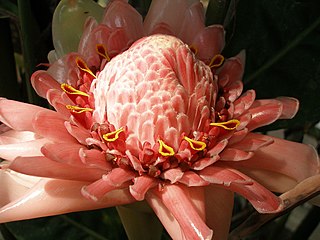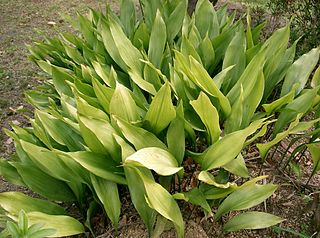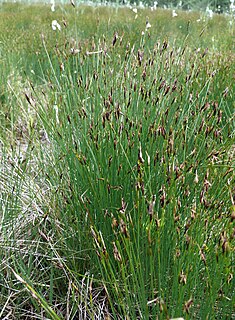There are over 190 vascular plant species on the Norwegian Arctic archipelago of Svalbard. This figure does not include algae, mosses, and lichens, which are non-vascular plants. For an island so far north, this number of species constitutes an astonishing variety of plant life. Because of the harsh climate and the short growing season, all the plants are slow growing. They seldom grow higher than 10 cm (4 in)

Etlingera elatior is a species of herbaceous perennial plant. Botanical synonyms include Nicolaia elatior, Phaeomeria magnifica, Nicolaia speciosa, Phaeomeria speciosa, Alpinia elatior, and Alpinia magnifica.

Eugenia koolauensis, commonly known as Koʻolau eugenia or nioi, is a species of flowering plant in the myrtle family, Myrtaceae. It is endemic to Hawaii, where it could previously be found on the islands of Molokaʻi and Oʻahu; today populations only exist on the latter. This is a federally listed endangered species of the United States.

Aspidistra elatior, the cast-iron-plant or bar-room plant, also known in Japanese as haran or baran (葉蘭) is a species of flowering plant in the family Asparagaceae, native to Japan and Taiwan. Tolerant of neglect, it is widely cultivated as a houseplant, but can also be grown outside in shade where temperatures remain above −5 °C (23 °F). It is used as training material for the seika form of ikebana.

Schoenus is a predominately austral genus of sedges, commonly known as bogrushes, or veldrushes in South Africa. Species of this genus occur mainly in South Africa, Australia and Southeast Asia. Others are found in scattered locations worldwide, from Europe to Asia, North Africa and the Americas. Three species occur in the peatlands of southern South America, including S. antarcticus which is found in Tierra del Fuego, where it forms a component of hyperhumid Magellanic moorland.

Kosířské lomy is a national nature monument in the Olomouc Region of the Czech Republic.
Carex tereticaulis, also known as basket sedge, is a species of sedge of the family Cyperaceae that is native to southern parts of Western Australia, southern parts of South Australia, southern and eastern parts of New South Wales as well as north western and central Victoria and Tasmania. The Koori peoples know the plant as Poong'ort.

Carex viridula, known as little green sedge, green sedge, or greenish sedge, is a small flowering plant native to North America, Europe, Asia, and Morocco.

Cyperus entrerianus, commonly known as the woodrush flatsedge, is a species of sedge that is native to southern parts of North America, Central America, and parts of South America.
Carex steudneri is a tussock-forming species of perennial sedge in the family Cyperaceae. It is native to the eastern part of Africa from Ethiopia in the north to South Africa.

Carex cruenta is a tussock-forming species of perennial sedge in the family Cyperaceae. It is native to parts of Asia, from Pakistan in the west to south central parts of China in the east.

Carex donnell-smithii is a tussock-forming species of perennial sedge in the family Cyperaceae. It is native to parts of Mexico and Central America.

Carex gravida, also known as heavy-fruited sedge, heavy sedge or long-awned bracted sedge, is a tussock-forming species of perennial sedge in the family Cyperaceae. It is native to southern parts of Canada and parts of the United States.

Carex hendersonii, also known as Henderson's sedge or carex de Henderson, is a tussock-forming species of perennial sedge in the family Cyperaceae. It is native to western parts of North America.
Carex burchelliana is a tussock-forming species of perennial sedge in the family Cyperaceae. It is native to parts of South Africa.
Carex catharinensis is a tussock-forming species of perennial sedge in the family Cyperaceae. It is native to parts of eastern parts of South America.
Carex ceylanica is a tussock-forming species of perennial sedge in the family Cyperaceae. It is native to parts of Sri Lanka.
Carex diminuta is a tussock-forming species of perennial sedge in the family Cyperaceae. It is native to parts of China.










